abaxial: on the side that is away from the axis (in leaves, the underside)
achene: a dry, indehiscent, one-seeded fruit, with seed attached to pericarp at a single point
acuminate: tapering gradually to a point and forming more or less concave sides
adaxial: on the side that is towards the axis (in leaves, the upper side)
alveolate: honeycombed
anatropous ovule: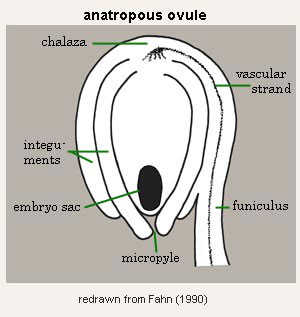 an ovule which is inverted and adnate to the funiculus, with the micropyle adjoining the funiculus
an ovule which is inverted and adnate to the funiculus, with the micropyle adjoining the funiculus
annular: forming a ring
antrorse: (adv. antrorsely) curved or bent toward the apex (as in 'antrorsely barbed')
apex: the point farthest from the point of attachment
areole: in the Cactaceae, a small, specialized area on the stem bearing spines and hairs
article: section of a fruit separated from other sections by a constricted joint
section of a fruit separated from other sections by a constricted joint
awn: a narrow, bristle-like organ, as on the glumes or lemmas of grasses
axile: on or of the axis
axis: a straight line through the center of a structure around which the parts are usually symmetrically arranged (geometry); the main stem (botany)
barbed: (of awns or bristles) with short, sharp, hairlike processes
basal: at or pertaining to the point of attachment
berry: an indehiscent, few- to many-seeded fruit from a single pistil, in which the pericarp becomes entirely fleshy
bifid: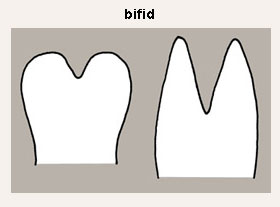 two-lobed or two-cleft
two-lobed or two-cleft
bristle: a stiff hair or hair-like structure
bulb: an underground vertical shoot that has modified leaves (or thickened leaf bases) that are used as food storage organs by a dormant plant
callus: the hard base of grass florets or spikelets, just above the point of disarticulation
calyx: the outer whorl of the perianth; all the sepals of a flower
capsule: a dry, dehiscent fruit formed by two or more carpels
carpopodium: an elongation of the base of the gynoecium which looks distinct, as in the achenes of some Asteraceae
cartilaginous: tough and firm but flexible; like cartilage
caruncle: a localized outgrowth of the seed coat near the hilum of the seed in some members of the Euphorbiaceae; it functions as an eliaosome
caryopsis: a dry, indehiscent, one-seeded fruit in which the seed coat is fused to the pericarp in the hilar region only, as in most grasses
caudate: tapering to a long, tail-like appendage
tapering to a long, tail-like appendage
chalaza: the region at the base of the ovule where the integuments are inserted
the region at the base of the ovule where the integuments are inserted
chartaceous: papery
ciliate: with a marginal fringe of hairs
clavate: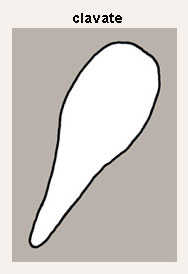 club-shaped, with attachment at or near narrow end (compare obclavate)
club-shaped, with attachment at or near narrow end (compare obclavate)
commissure: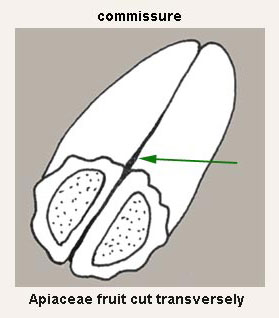 the face along which two carpels join, as in the Apiaceae
the face along which two carpels join, as in the Apiaceae
compressed: flattened; in grasses, used to denote compression (not necessarily flattened) either laterally or dorsiventrally
connivent: converging but not fused
cordate: heart-shaped, with attachment at or near the broad end (compare obcordate)
coriaceous: leathery
corolla: the inner whorl(s) of the perianth; all the petals of a flower
cotyledon: a primary leaf of the embryo
craspedium: a one-carpellate fruit splitting transversely into one-seeded segments; seed-bearing segments separate from each other and from the persistent sutures (see fruits of Mimosa diplotricha and Mimosa pigra)
crenate: having a margin with low, rounded or scalloped projections
cyanobacteria: unicellular, filamentous or colonial photosynthetic bacteria in the kingdom Eubacteria, formerly known as "blue-green algae"
deciduous: falling off; not persistent
dehiscent: (v. dehisce) splitting open at maturity to release contents (of a fruit)
dimorphic: occurring in two forms
dioecious: having separate male and female flowers on different individuals of the same species
discoid: resembling a disc
disseminule: detachable plant part capable of being disseminated and of propagating, commonly a seed or fruit
dorsal: the back of an organ; the side away from the axis (compare ventral)
dorsiventral: pertaining to the dorsal and ventral surfaces
drupe: a fleshy, indehiscent fruit with a stony endocarp
drupelet: one drupe of a fruit with multiple drupes, as in blackberries
elaiosome: A lipid and protein-rich fleshy structure attached to some seeds and fruits, it attracts ants which then disperse the disseminule. Examples include the caruncle in the Euphorbiaceae, the aril (outgrowth of the funiculus) in the Fabaceae, and the structure found at the base of some fruits in the Asteraceae.
elliptic: oval
emarginate: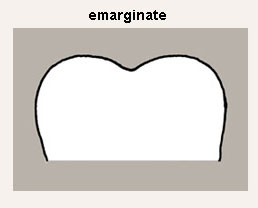 with a shallow notch at apex
with a shallow notch at apex
embryotega: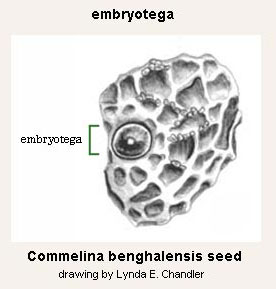 an outgrowth on the seed coat, as in the Commelinaceae
an outgrowth on the seed coat, as in the Commelinaceae
emersed: rising from and standing above the water
endocarp: the inner layer of the pericarp
endosperm: nutritive starch- and oil-containing tissue present in many seeds
exocarp: the outer layer of the pericarp
falcate: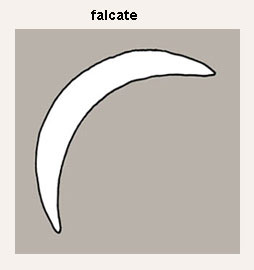 shaped like a scythe or sickle
shaped like a scythe or sickle
fascicle: a highly reduced branch of a spicate grass panicle consisting of 1–3 whorls of free or fused bristles disarticulating with the spikelets at maturity
fertile floret: a grass floret capable of producing fruit; the fertile floret may possess both male and female, or just female, reproductive structures
flanged: with a projecting rim or edge
floret: the unit of a grass spikelet consisting of a flower or caryopsis, with lemma and palea
frond: the leaf of a fern
funiculus: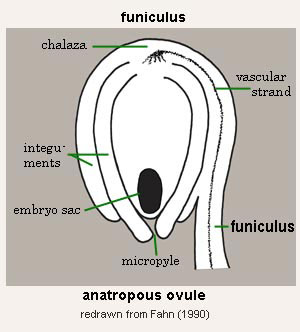 stalk by which the ovule (later seed) is attached to the placenta in the fruit
stalk by which the ovule (later seed) is attached to the placenta in the fruit
fusiform: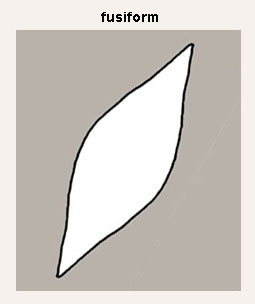 spindle-shaped; broadest at the middle and tapering at both ends
spindle-shaped; broadest at the middle and tapering at both ends
geniculate: bent like a knee
gibbous: swollen on one side
glabrous: without hairs
glistening: sparkling with reflected light
globose: spherical
glochidium: (pl. glochidia) a hair-like process bearing an anchor-like tip, that projects from the surface of microsporangial massulae in the Salviniaceae
glossy: shiny
glume: one of the (usually) two bracts at the base of a grass spikelet
granular: having a grainy surface
hilar: of or relating to a hilum
hilum: on seeds, the scar indicating where the funiculus was attached; on grass caryopses, the scar visible on the outer caryopsis surface revealing where the seed is attached on the inner fruit wall surface
hippocrepiform: horseshoe-shaped
hyaline: thin, membranous, and translucent or transparent
hypocotyl: portion of the embryonic axis below the cotyledons and above the radicle
incumbent: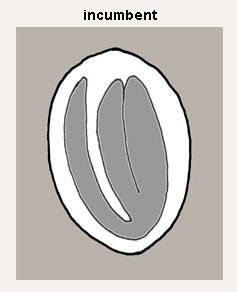 (of cotyledons) having the dorsal side of one cotyledon resting against the radicle
(of cotyledons) having the dorsal side of one cotyledon resting against the radicle
indehiscent: not opening on its own, as in a fruit
indurate: hardened
integument: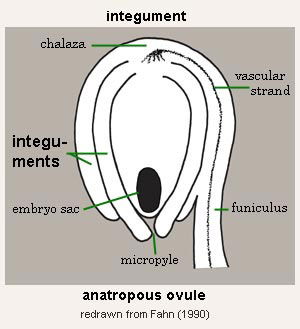 the outer cell layer (or layers) of the ovule that develops into the seed coat
the outer cell layer (or layers) of the ovule that develops into the seed coat
internode: portion of a stem between two nodes
involucre: in the grasses, a whorl or cluster of bracts or bristles subtending a floret or spikelet
isthmus: (pl. isthmi) a narrow strip of tissue connecting two larger parts
keel: a longitudinal ridge formed by the lengthwise folding of a structure, such as a lemma or palea
lanceolate: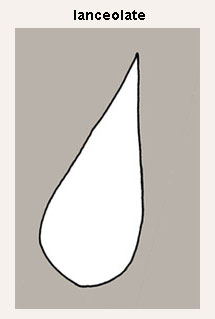 lance-shaped; widest point below the middle, tapering to the apex (compare oblanceolate)
lance-shaped; widest point below the middle, tapering to the apex (compare oblanceolate)
lateral: of, at, or from the side; in grasses, can refer to the sides adjacent to the dorsal and ventral sides
legume: a usually dry, dehiscent fruit derived from a single carpel that opens along two longitudinal sutures
lemma: in grasses, the lower of the two bracts subtending the flower or caryopsis (compare palea)
lens: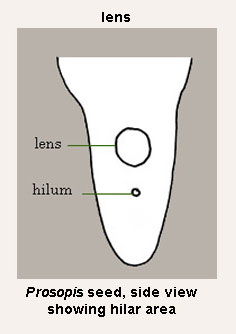 a mound, pad, or area of tissue situated near the hilum on seeds in the Mimosoideae and Caesalpinioideae
a mound, pad, or area of tissue situated near the hilum on seeds in the Mimosoideae and Caesalpinioideae
lenticular: lens-shaped; biconvex
loculicidal: dehiscence or splitting along the walls of the locules (chambers or cavities) of a fruit, rather than along the septa (compare septicidal)
loment: a usually dry fruit derived from a single carpel that breaks transversely into one-seeded fruit segments
lomentoid: resembling a loment
lustrous: semiglossy
marginal: at, on, or close to the margin or border
massula: (pl. massulae) in Azolla, a mucilaginous group of microspores within the microsporangium
megasporangium: A hollow structure in which megaspores (haploid spores that develop into female gametophytes) are produced. In Azolla, the megasporangium (or megasporocarp) is in two parts. The lower part contains only one megaspore, and the upper part is filled with 'floats'.
membranous: thin, more or less translucent, flexible; like a membrane
mericarp: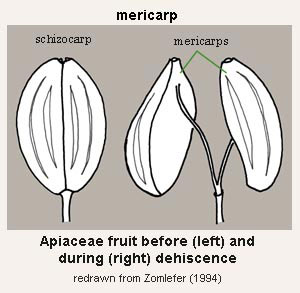 a one-seeded section (carpel) of a schizocarp, as in Apiaceae fruits (compare schizocarp)
a one-seeded section (carpel) of a schizocarp, as in Apiaceae fruits (compare schizocarp)
mesocarp: the middle layer of the pericarp
micropyle: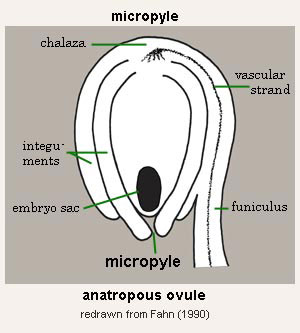 an opening in the integuments of an ovule usually acting as a passage for the pollen tube
an opening in the integuments of an ovule usually acting as a passage for the pollen tube
microsporangium: a hollow structure in which microspores (haploid spores that develop into male gametophytes) are produced
moniliform: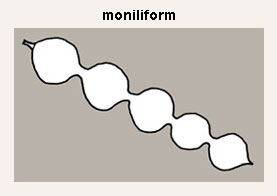 cylindrical and constricted at regular intervals; like a string of beads
cylindrical and constricted at regular intervals; like a string of beads
monoecious: having separate male and female flowers on the same individual
mottled: with colored spots, streaks, or blotches of a different color
mucronate: terminating with a short, sharp, abrupt tip
terminating with a short, sharp, abrupt tip
mucronulate: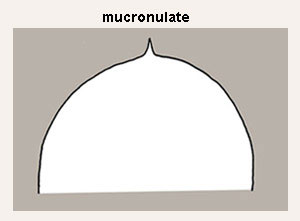 diminutive of mucronate
diminutive of mucronate
multiseriate: occurring in more than one series
muricate: rough with small, hard, sharp projections
obclavate: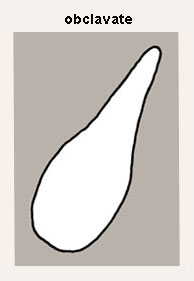 club-shaped, with attachment at or near the broad end (compare clavate)
club-shaped, with attachment at or near the broad end (compare clavate)
obconic: cone-shaped, with attachment at or near the narrow end
obcordate: heart-shaped, with attachment at or near the narrow end (compare cordate)
oblanceolate: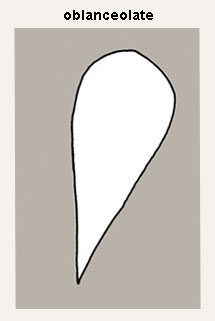 lance-shaped, with attachment at or near the narrow end (compare lanceolate)
lance-shaped, with attachment at or near the narrow end (compare lanceolate)
oblique: in a slanting direction or position, neither horizontal nor vertical
obovate: egg-shaped in outline, with attachment at or near the narrow end (compare ovate, ovoid)
obpyramidal: pyramid-shaped, with attachment at or near the narrow end (compare pyramidal)
obtrullate: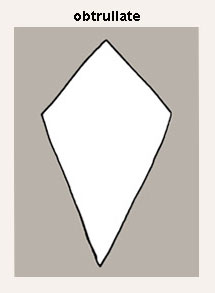 trowel-shaped, with attachment at or near the narrow end (compare trullate)
trowel-shaped, with attachment at or near the narrow end (compare trullate)
obtuse: with a blunt or rounded apex
with a blunt or rounded apex
omega: the last letter in the Greek alphabet
the last letter in the Greek alphabet
orbicular: circular in outline
ovate: egg-shaped in outline, generally with attachment at or near the broad end (compare obovate, ovoid)
ovoid: egg-shaped in three dimensions
palea: in grasses, the uppermost bract enclosing the flower or caryopsis (compare lemma)
palmate: with leaflets or lobes radiating from the base of the leaf
papillate: bearing minute, rounded, nipple-like projections
pappus: the modified calyx in the Asteraceae, composed of hairs, bristles, awns, or scales
the modified calyx in the Asteraceae, composed of hairs, bristles, awns, or scales
pedicel: the stalk of a flower, inflorescence, or grass spikelet
pedicellate: borne on a pedicel
perianth: collective term for calyx and corolla of a flower
pericarp: the fruit wall
perisperm: seed nutritive tissue comparable to the endosperm, but derived from the nucellus – maternal tissue
pilose: having thin, soft, long hairs
pinnae: a leaflet or primary division of a pinnately compound leaf, as in ferns
pinnate: with leaflets on each side of a common axis in a featherlike arrangement
pinnule: smallest divisions of a leaf which is doubly compound, especially in ferns
placenta: place inside the ovary that bears ovules
plano-convex: flat on one side, convex on the other
pleurogram: a U-shaped line on both seed faces resulting from modification of the face of the ovule during seed development, present in some species' seeds in the Fabaceae subfamilies Mimosoideae and Caesalpinioideae
a U-shaped line on both seed faces resulting from modification of the face of the ovule during seed development, present in some species' seeds in the Fabaceae subfamilies Mimosoideae and Caesalpinioideae
plumose: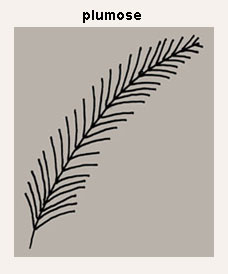 (of a hair or bristle) feather-like
(of a hair or bristle) feather-like
puberulent: (or puberulous) bearing minute, soft hairs
pubescent: bearing hairs
punctiform: like a point
pyramidal: pyramid-shaped (compare obpyramidal)
quadrate: more or less square
rachilla: the main axis of the spikelet in grasses
rachis: the main axis of the inflorescence in grasses or of a compound leaf (frond) in ferns
radicle: the embryonic root of the embryo
the embryonic root of the embryo
raphe: a ridge or seam on a seed formed by the portion of the funiculus adnate to the ovule, as in anatropous ovules
reniform: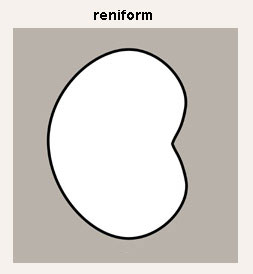 kidney-shaped
kidney-shaped
reticulate: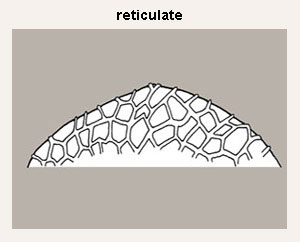 in the form of a network; netted
in the form of a network; netted
revolute: with margins rolled downward, or to the lower side
rhizoid: a rootlike structure lacking xylem and phloem, as in algae and fungi
rhizome: a thickish horizontal underground stem producing roots and shoots
rhombic: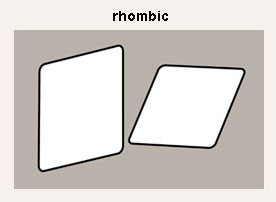 diamond-shaped in outline; having the form of a rhombus
diamond-shaped in outline; having the form of a rhombus
rugose: wrinkled
scaberulous: rough to the touch because of minute projections
scale: general term for short, thin, flat bracts or hairs
scarious: dry, thin, membranous, non-green, more or less translucent
schizocarp: a dry fruit that splits into two or more one-seeded indehiscent segments (carpels) (compare mericarp)
a dry fruit that splits into two or more one-seeded indehiscent segments (carpels) (compare mericarp)
scurfy: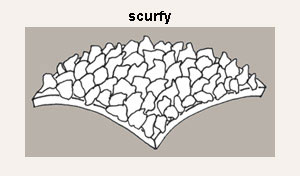 covered with small, branlike scales
covered with small, branlike scales
scutellum: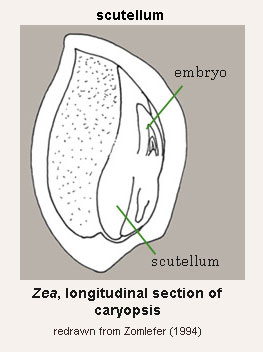 the single, relatively large cotyledon of a grass embryo
the single, relatively large cotyledon of a grass embryo
sectoroid: in the form of an orange or apple section
sepal: a member of the outer envelope of a flower (calyx)
septicidal: dehiscence or splitting along the septa of a fruit, rather than along the walls of the locules (compare loculicidal)
septum: (pl. septa) a dividing cross wall or partition
serrate: having a saw-toothed margin, i.e., a margin notched with toothlike projections
serrulate: a minutely serrate margin
sessile: attached without a stalk
spatulate: like a spatula; rounded at the apex, with base long and tapered
like a spatula; rounded at the apex, with base long and tapered
spicule: a small, pointed, epidermal appendage
spikelet: basic unit of the grass inflorescence, commonly consisting of a pair of glumes and one to many florets
sporangium: a structure in which spores are produced, as in ferns
spore: in ferns, a haploid reproductive structure adapted for dispersal and surviving for extended periods in unfavorable environmental conditions
stellate: star-shaped; with radiating branches
sterile: lacking male and/or female flower parts; also, not producing fruit or seed
stipe: a stalk
stipitate: borne on a stalk
stolon: a horizontal stem at the ground surface, forming adventitious roots at the nodes or the apex, and forming new plants
striate: having fine, parallel lines, grooves, or ridges
style: in a flower, the narrow and elongated part of the pistil between the stigma and the ovary
style base: remnant of a style, as at the apex of Asteraceae achenes
sub-: a prefix meaning slightly, somewhat, or nearly (used with a descriptive term), or below (used with an anatomical term)
submersed: under water, submerged
suture: a line of fusion; a seam
tannic: astringent, bitter-tasting
tawny: brownish-yellow; tan
tepal: a member of the perianth, when it cannot be differentiated into a calyx and corolla
terete: approximately circular in cross section; width and thickness approximately equal
testa: seed coat
tomentellous: slightly tomentose
tomentose: pubescence that is bent and matted, forming a woolly coating; often the hairs are silver or gray-colored
transverse: lying, situated, or placed across
trichome: a hair or hairlike outgrowth of the epidermis
trullate: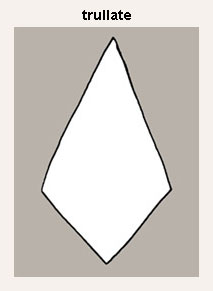 trowel-shaped, generally with the attachment at or near the broad end (compare obtrullate)
trowel-shaped, generally with the attachment at or near the broad end (compare obtrullate)
truncate: terminating abruptly, as if cut straight across
tuberculate: bearing small, warty, swelling, rounded, or variously shaped projections
turion: a perennating bud produced by many aquatic plants, which detaches from the parent plant and remains dormant until the following spring
umbo: a rounded protuberance on both faces of some seeds in the Mimosoideae, such as those of Prosopis
undulate: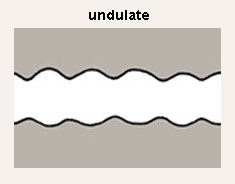 wavy-margined
wavy-margined
utricle: a dry, thin-walled fruit with a free single seed
valve: in fruits, one of the parts into which a fruit separates at maturity
ventral: of the side of an organ facing the axis (compare dorsal)
verrucose: covered with wartlike projections
villous: covered with long, soft, fine hairs
vitta: (pl. vittae) an oil or resin tube in the pericarp of many Apiaceae fruits
waisted: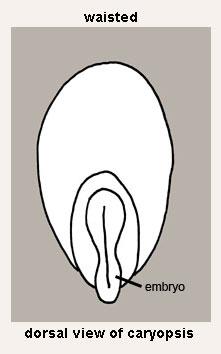 in grass caryopses, refers to an embryo visible on the caryopsis surface that is constricted in the middle
in grass caryopses, refers to an embryo visible on the caryopsis surface that is constricted in the middle